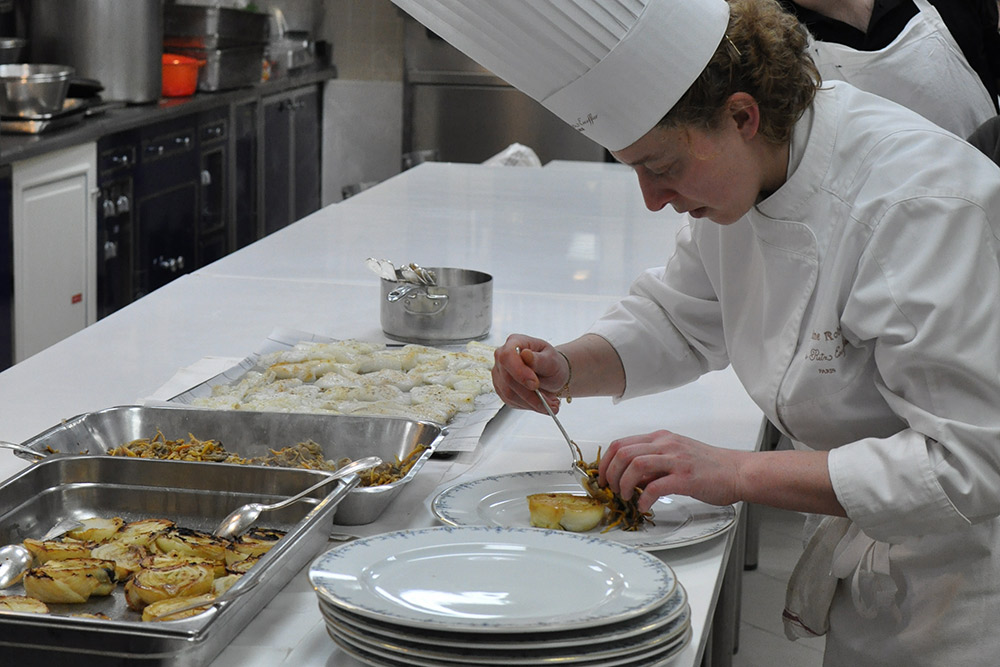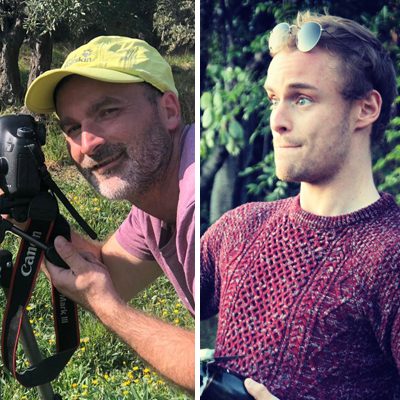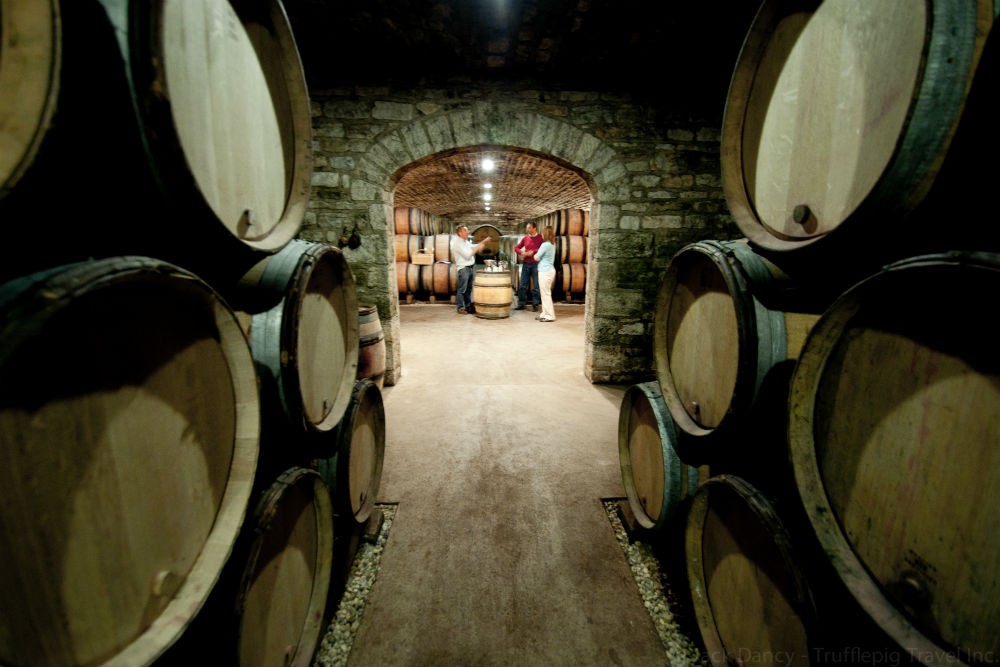Paris for Food Lovers: Insider’s Guide
 Cooking class at the Ritz, Place Vendôme, Paris . Photo courtesy Jack Dancy/Trufflepig
Cooking class at the Ritz, Place Vendôme, Paris . Photo courtesy Jack Dancy/Trufflepig
The insider advice on this page is from two of Wendy’s Trusted Travel Experts for France: Michael Eloy and Alex Zglinski.
You might say that their job training started at birth: Michael and Alex grew up in France’s famed regions of Provence and Burgundy, respectively, alongside the next generation of winemakers, restaurateurs, farmers, and private guides. Today, still living near their hometowns, they sprinkle these local connections throughout their itineraries, helping independent-minded travelers—especially those who want to rent a car and explore on their own—to experience the best of what’s off the beaten track in France. Their in-depth itineraries will ensure that you drive the most scenic roads, sleep in the most charming and unusual accommodations, and dine in the most authentic local eateries. They’ve got their finger on the pulse of what’s new and exciting but still under-the-radar, as well as what’s old and magically atmospheric that most travelers miss. Use them for wine tasting in Burgundy, chateau-hopping in the Loire Valley, hiking in the Dordogne, cycling in Corsica (Michael used to be a biking guide), exploring Paris (where Alex has lived) by vintage Citroen, stepping back in time at WWI and WWII sites, or road tripping through all of it and then on into Belgium, the Netherlands, Germany, Spain, Italy, or Switzerland. Contact Michael and Alex only for trips of one week or longer, and note that their pricing (see above their photos) includes all hotels (or villa/apartment rental), regional flights or trains, car rental, visits and guided excursions, and some meals.
Where to Stay and Eat
Best bang-for-your-buck hotel
The Pavillon de la Reine in the Marais. It’s not cheap, but its most expensive suite goes for the same price as a standard double in the palace hotels. Run with discreet professionalism and a (not always present in Paris) smile, it offers Michael and Alex’s travelers its best rates and free breakfasts.

Les Ambassadeurs restaurant set for lunch, Hotel le Crillon. Photo courtesy Jack Dancy/Trufflepig
Restaurant the locals love
Le Sévero in the fourteenth arrondissement, for steak and frîtes. You know the food must be good when a restaurant is run by a man (a butcher, in this case) with literally none of the usual hospitable graces, utterly unbending in the application of the house rules, all designed to make sure your meal is terrific, not that your whims are accommodated. No mustard allowed. All steaks served rare. Don’t even whisper the word ketchup within 500 meters of the front door.
Chez Casimir, in the tenth arrondissement, for an excellently priced prix fixe lunch or dinner, with a great cheese trolley (which have all but disappeared in the low- to mid-range restos).
Auvergne ham and Cantal cheese baguette sandwich at Le Petit Vendome in the second arrondissement, a restaurant that defines the word bustling at lunchtime; it offers a sandwich service from the bar, which is worth the elbow-fight to get to.
Don’t-miss dish
You may think of the croque-monsieur as French, but more specifically it’s Parisian, and indeed the untoasted-baguette version (a simple ham-and-cheese sandwich) is called a Parisien. Proust gives the sandwich its first literary outing, in A la Recherche du Temps Perdu, published in 1913. The croque-monsieur is therefore at once a cultural, historic, and artistic way of saving 40 euros at lunchtime, eating on the trot, and saving your appetite for dinner. The best is at the sandwich shop of the ancient Julhes deli on the rue du Faubourg St Denis.
Meal worth the splurge
Three-star Michelin restaurants are both extraordinarily good and extraordinarily expensive. Beneath those, it’s really very easy to eat extremely well for 40 to 50 euros per person including wine. So a useful tip is to split the difference, perhaps at the Carré des Feuillants by chef Alain Dutournier, originally from southwest France but now a fully adopted Parisian. Why? Because for 60 euros you can have the prix fixe lunch, which is a great way for those on a tighter budget to try a top restaurant at a really decent price (especially given that most people think he should have three stars). Then, at the other end of the scale, for the bargain price of 200 euros per person (for tables of five and up), you can tuck into the Grand Menu, a five-course extravaganza that includes aperitif, wines, water, and coffee. What’s more, he can cater to kosher clients, and he offers 35 percent for clients under 35. Who said French cuisine wasn’t moving with the times!

View past Les Invalides to the Eiffel Tower, Paris. Photo courtesy Jack Dancy/Trufflepig
Prime picnic spot
On the banks of the Seine, on the Île St Louis, just beneath the Quai d’Orléans, looking up to Notre Dame across the river. It’s an absolutely unbeatable view, and there’s a cobbled sitting area beneath the trees for the perfect evening picnic.
What to See and Do
Don’t miss
The “other side” of the Butte Montmartre—the eighteenth arrondissement beyond Sacré Coeur. The neighborhoods on the far side of the hill of Montmartre are mostly residential areas, home to African and Caribbean immigrants, newly arrived hipsters, and more traditional French families who’ve been there forever, such that the combination makes for a great mix of influences. Exotic and foreign, trendy and utterly, gallically old-fashioned—all for the most part curiously devoid of tourists and well provided with decent restaurants, cafés, and markets (whereas around Sacré Coeur and even in Abbesses there is hardly a good spot to eat). It’s a great area to explore.
Take in a sporting event. It’s not for everyone, of course, but it’s easy to pick up tickets to see Stade Français play rugby at the new Stade Jean Bouin, or Paris St Germain play soccer at the Parc des Princes; or to head to the hippodrome in the Bois de Boulogne, or the far more picturesque setting of Chantilly. Particularly at the rugby matches, the locals will be surprised to see you there, and will enthusiastically adopt anyone showing the slightest glimmer of enthusiasm. For the especially keen, Michael and Alex can have a local sports journalist host you for the day, and take you for lunch with the superfans beforehand.
Don’t bother
Having dinner or lunch on a bateau mouche. Although the boats that ply the Seine are worth doing, you should never eat on one. In a city that’s heaving with good restaurants, it makes no sense to eat bad food prepared from frozen in a boat kitchen.
Visiting Monet’s gardens at Giverny. Unless you have a furiously active interest in this particular style of gardening or in the life and work of Monet himself, there are better gardens to visit for the layperson, and there are better places to see Monet paintings or to connect with the history of the artist and his contemporaries.
Cheap thrill
A self-guided walk in Paris. Fill a half day, or a full day, or your entire trip, strolling with Michael and Alex’s guidance through different neighborhoods, getting out your wallet only for meals along the way (bearing in mind it’s hard to go one minute in Paris without passing a boulangerie).
How to spend a Sunday
Start off with coffee and people-watching on the rue Cler in the seventh arrondissement, where the weekend morning scene is particularly pleasant; then head to the church of St Sulpice for the weekly organ recital at 11:30 a.m. (the pipe organ at St Sulpice is one of the finest in the world); picnic in the Jardins de Luxembourg or lunch in the gardens of the Musée Rodin; then take in a movie in one of the many art-house cinemas in Paris—known for having more movies showing per day than any other city in the world, many in English; have a tartine of pain poilâne and a glass of wine at the Chai de l’Abbaye in the sixth; finish the day at the Caveau de la Huchette or the Caveau des Oubliettes for some live jazz, both open on Sundays.
Instagram moment
The pétanque (boules) court in the Jardins de Luxembourg, where the sign telling you that only members of the Association Sportive des Jardins de Luxembourg are allowed seems perfectly in tune with the looks of fierce concentration on the faces of those playing. Oh, and the backdrop’s not bad either.
Perfect souvenir
Visit Gab & Jo in the sixth, and pick up a pair of red, white, and blue Y-fronts made by Le Slip Français.
Best Time to Go
There’s no bad time to go to Paris—so if your calendar is tight and your choices are limited, there’s never a reason not to go, even it’s fashion week or it’s August or there’s a national holiday. Each month has its particular pros and cons (e.g. February: dismal weather but far fewer tourists), and the only two particular periods when planning really changes are Christmas/New Year’s and the month of August. Many shops and restaurants are closed in August, but on the other hand, the city has far less traffic, and although the Opéra de Paris is out of season, there are a multitude of smaller concerts and cultural events laid on for those who haven’t left on holiday. At the other end of the calendar, Christmas/New Year’s is one of the prettiest times in the city, which is already beautifully lit even before the seasonal lights go up, but it’s important to be aware of Christmas/New Year’s closing times, expensive set menus in restaurants on Dec 31, and the sheer difficulty of getting around the city that evening.
Biggest Rookie Mistake
Getting blinded by the need to tick off the major sites. If you come to Paris for three days, think hard about what your interests really are, and have the courage to miss out on sites or museums that you feel you ought to visit, or that your friends will chastise you for missing. Many travelers think they have to see the Louvre and the Musée d’Orsay and the Pompidou and Notre Dame and the Eiffel Tower . . . the list goes on. You can fill a week visiting all the star attractions and spending much of your time surrounded by foreign tourists and missing any sense of the living, present-day city of Paris. If it’s your first time in the city and you only have three days, plan to visit perhaps one museum and one temporary exhibit or show, and leave plenty of time for strolling, wandering around some markets, taking in some of the parks, getting out of the central neighborhoods, taking a guided walk or a class (Michael and Alex can recommend all different sorts of cooking and art classes), and making sure your precious time is spent doing things that are actually of interest to you.
Must-Have App
The RATP public transport app, which tells you which buses, trams, or metros to take to get anywhere in the city, as well as how long any given trip will take. With taxis so hard to rustle up, public transport is second only to biking as a way to navigate the city.
Airport Intel
If you’re more than four people, it’s cheaper to have a private driver meet you, since most taxis won’t take more than three passengers. And if you’re three people with a lot of luggage, you may have to wait a while for a large taxi to turn up, so you may want to consider paying the 60 euros extra for a private car. Otherwise, taxis are easily found at both airports. Not all of them take credit cards, so you should have cash available.
Tipping Tip
People tip less in France than in the United States, but that doesn’t mean people don’t appreciate being tipped! So tip small (a few coins here and there), but tip always.
Don’t Forget to Pack
Smart shoes. The biggest difference between French and North American dress is in the shoes. If blending in is something you’re keen on, start at the feet and work up.









